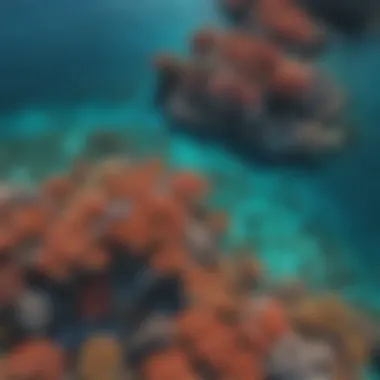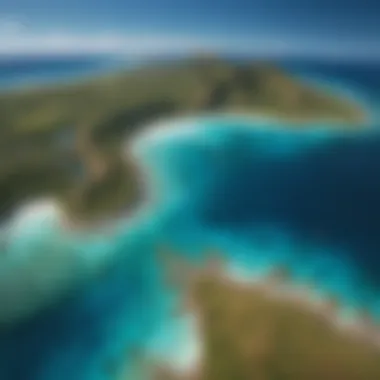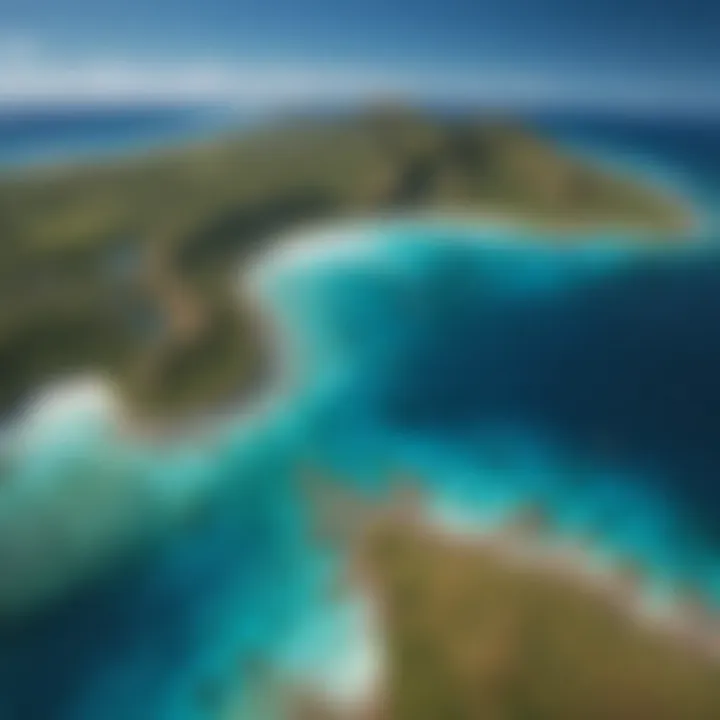The Great Barrier Reef: Location and Ecological Significance


Intro
The Great Barrier Reef, stretching over 2,300 kilometers along the northeastern coast of Australia, is a breathtaking ecological treasure that draws millions of visitors each year. Nestled in the Coral Sea, this vibrant ecosystem is more than just a collection of corals and marine life; it serves as a vital indicator of environmental health and a refuge for countless species of fish, mollusks, and marine mammals.
Not only does it boast an impressive variety of habitats, but the reef also holds significant cultural importance, particularly for the Indigenous peoples of Australia. Understanding its location and significance requires more than just admiration of its beauty; it invites us into a narrative of an intricate web of life, human interaction, and conservation efforts that aim to preserve this stunning marvel for future generations.
In this exploration, we'll journey beyond the surface to discover the reef’s geographic coordinates, its surrounding features, and what makes it a UNESCO World Heritage Site. We'll delve deeper into why it matters ecologically and offer insights into the threats it faces and the steps being taken to conserve it. As we navigate through this article, readers will gain a holistic understanding of the Great Barrier Reef and perhaps a new appreciation for this unique ecosystem in our world.
Prelude to the Great Barrier Reef
The Great Barrier Reef stands as one of the most recognized natural wonders on our planet. It stretches over 2,300 kilometers along the northeastern coast of Australia, captivating the attention of scientists, travelers, and outdoor enthusiasts alike. This section delves into why understanding the Great Barrier Reef's introduction is vital for all who value marine ecosystems and biodiversity.
The introduction provides a framework to appreciate the ecological richness of the reef, as well as its geographic significance. Understanding the reef isn't just an academic exercise; it directly informs conservation efforts and tourism practices critical to preserving its beauty and health for future generations.
Overview of the Great Barrier Reef
Nestled in the Coral Sea, the Great Barrier Reef is the largest coral reef system in the world. Comprising over 2,900 individual reefs, this natural spectacle supports an astonishing variety of marine life. Scientists estimate that more than 1,500 species of fish, 400 types of coral, and countless invertebrates live within this sprawling aquatic haven. Each component plays a role in maintaining the delicate balance of the ecosystem, highlighting its complexity.
In addition to incredible biodiversity, the reef's geography plays a crucial role in its significance. The waters surrounding the Great Barrier Reef are generally warm and clear, creating ideal conditions for coral growth. Throughout its history, this ecosystem has thrived, evolving alongside changing climatic conditions for thousands of years. Visitors can experience the vivid blues and greens of the water, while the various hues of coral shimmer beneath the surface, creating an underwater landscape like no other.
Why the Reef Matters
Why should anyone care about the Great Barrier Reef? The answer is woven into multiple strands of ecological, economic, and cultural significance. Firstly, the reef acts as a natural barrier protecting coastal regions from waves and storms, effectively acting as a shield for nearby communities.
Moreover, the Great Barrier Reef serves as a biological treasure trove. It is a nursery and habitat for countless marine species, providing essential spawning grounds for fish that are vital to local fisheries. Economically, it contributes an estimated 6 billion Australian dollars per year through tourism, supporting jobs and livelihoods.
The Great Barrier Reef is often cited as a model for marine conservation efforts worldwide, emphasizing the importance of protecting such ecosystems from human activities.
Ultimately, the value of the Great Barrier Reef transcends mere beauty. It's a living, breathing entity and a significant contributor to global biodiversity and environmental health. By learning about its importance, visitors cultivate a sense of responsibility toward this natural wonder, ready to play a part in its conservation.
Geographic Location of the Great Barrier Reef
The geographic location of the Great Barrier Reef plays a pivotal role in understanding its ecological significance. This UNESCO World Heritage Site stretches along the coast of Queensland, Australia, providing a vibrant ecosystem that supports countless marine species. The proximity to the continent not only influences the biodiversity found here but also impacts conservation efforts and tourism. Moreover, the visual beauty of the reef, viewed from land or sea, highlights the interplay between natural structures and human activity in this region.
Coordinates of the Reef
When discussing the Great Barrier Reef, one cannot overlook its coordinates: approximately 18 degrees south latitude and 147 degrees east longitude. These specific numerical values position the reef between the tropical and subtropical zones, which somewhat contributes to its lush biodiversity. Being situated near the Coral Sea, the reef is nurtured by warm waters that are advantageous for coral growth. The coordinates not only help in navigation but also serve as a benchmark for studies related to climate change and marine health.
Surrounding Landmarks
Queensland, Australia
Queensland serves as the gateway to the Great Barrier Reef, offering more than just access to marine wonders. This state is marked by a warm climate, beautiful landscapes, and a rich cultural tapestry. The key characteristic of Queensland is its diverse ecosystems, ranging from towering rainforests to striking coastlines. These features provide various opportunities for adventurers, including surfers and outdoor enthusiasts, looking to engage with nature.
One unique aspect of Queensland is the access to several islands that form part of the reef system. Locations like the Whitsunday Islands present a natural paradise for scuba diving and snorkeling. However, the popularity of these areas comes with challenges, such as increased tourist traffic impacting the ecosystems. In exploring Queensland's relationship to the reef, it becomes clear that while this region is a sought-after destination, it is equally critical to approach it with care.
Coral Sea
The Coral Sea is another vital landmark in the discussion of the Great Barrier Reef. This body of water is known for its clarity and rich marine life, making it a prime location for both leisure and research. The sea’s role is multifaceted, acting as a barrier against harsh weather while supporting diverse marine habitats. Notably, the key features of the Coral Sea include its warm waters that sustain coral growth and its importance as a habitat for species such as turtles and dolphins.
Yet, like many natural areas, the Coral Sea faces its own set of challenges. Issues such as pollution and overfishing can have severe ramifications on the health of the reef. The unique relationship between the Coral Sea and the reef underscores the necessity for ongoing monitoring and responsible tourism practices.
"The Great Barrier Reef is not just a list of coordinates; it is a vibrant ecosystem that reflects the delicate balance between nature and human influence. Cultural, ecological, and economic factors all intertwine to shape its future."
In summary, understanding the geographic location of the Great Barrier Reef enhances our appreciation for its complexity. The coordinates help position the reef accurately, while the surrounding landmarks such as Queensland and the Coral Sea invite a deeper exploration of the ecological systems at play. Every drop of water and grain of sand contributes to the story that the Great Barrier Reef tells.
Physical Features of the Great Barrier Reef
Understanding the physical features of the Great Barrier Reef is crucial to appreciating its ecological significance and beauty. Covering approximately 344,400 square kilometers, it stands as the largest coral reef system in the world, showcasing a rich kaleidoscope of life and structure beneath the waters. The reef hosts more than just coral; it comprises islands and cays that play a vital role in the ecosystem while also attracting visitors from around the globe.
Coral Formations


Coral formations within the Great Barrier Reef are essential building blocks of this ecosystem. Comprising over 400 different types of coral, these formations create stunning underwater landscapes. Each type of coral contributes uniquely, from the branching corals that provide habitats for myriad species to the massive boulder corals that serve as foundations for smaller marine life.
The significance of these formations goes beyond aesthetics. They act as natural barriers, protecting the coastlines and islands from the forces of waves and storms. Moreover, coral reefs support approximately 25% of all marine species, providing food and shelter for fish, mollusks, and crustaceans. The symbiotic relationship between corals and algae also aids in absorbing carbon dioxide while releasing oxygen, benefiting the broader environment.
"Coral reefs are often referred to as the rainforests of the sea due to their immense biodiversity."
Islands and Cays
In addition to coral structures, the Great Barrier Reef features numerous islands and cays, each with its own significance. Some, like Hamilton Island or Fitzroy Island, are well-known for their beauty and tourism appeal. These landmasses house not only stunning landscapes but also a myriad of terrestrial and marine species, creating diverse ecosystems that are often inextricably linked.
Islands often serve as breeding grounds for sea birds and turtles. They provide sanctuary away from predators that might threaten young marine life. Furthermore, many islands are recognized for their unique plant life, some of which can only be found in these specific environments.
The accessibility of these islands, especially through eco-friendly methods like boat rides or guided tours, allows outdoor enthusiasts and travelers to immerse themselves in this tropical paradise while fostering an appreciation for conservation.
Accessing the Great Barrier Reef
Accessing the Great Barrier Reef is not just about reaching a destination; it’s about embracing an experience. The way you get to this natural wonder can significantly enhance your understanding and appreciation of its vastness and beauty. It’s crucial to consider the main access points and available methods of transportation, as they provide insights into how best to make the most of your visit.
Main Access Points
Cairns
Cairns stands out as the primary gateway to the Great Barrier Reef. The city itself is bustling with activity, making it a lively hub for tourists. Its proximity to the reef means that visitors have quick access to numerous tour operators offering trips to various reef locations. One of the key characteristics of Cairns is its vibrant atmosphere, lined with cafés, restaurants, and markets that welcome travelers. The unique feature of Cairns is the availability of a wide range of excursions—everything from scuba diving to helicopter tours, catering to diverse interests and comfort levels. However, one must consider that Cairns can be quite crowded during peak tourist seasons, making it potentially overwhelming for some visitors who prefer a more laid-back experience.
Port Douglas
Just a short drive north of Cairns lies Port Douglas, an upscale alternative that many find appealing. Known for its stunning beaches and upscale resorts, Port Douglas is a beneficial choice for those who want a more tranquil environment while still having access to the reef. A notable feature of Port Douglas is the four-mile beach, taking visitors’ breath away with its golden sands and clear blue waters. It also serves as a launching pad for trips to the outer reef, which are known for their remarkable coral formations. On the downside, the exclusivity and luxury of Port Douglas often come with a higher price tag compared to its neighbors, which could deter budget-conscious travelers.
Whitsunday Islands
The Whitsunday Islands represent paradise on earth for many, showcasing a collection of 74 islands nestled between the Great Barrier Reef and the Queensland coast. This destination provides unique access to various reef locations while being surrounded by their pristine beaches and lush green landscapes. The island group is particularly popular among sailing enthusiasts; it's often seen as the gateway to some of the most breath-taking sights of the reef. Visitors can indulge in chartering a yacht or joining group sailing tours. While the Whitsundays provide stunning scenery, it is worth mentioning that the remoteness of some islands can lead to limited access during inclement weather, which might affect planned trips.
Best Methods of Transportation
Boats
Boats are the stalwarts of transportation when it comes to exploring the Great Barrier Reef. They offer a direct line to numerous points of interest without the need for complex travel arrangements. Moreover, boat tours often provide guided experiences, enriching your journey through narration about the reef's ecological significance. The unique aspect of boat travel is the chance to witness marine life up close, whether it's playful dolphins or majestic turtles while cruising. However, the downside can be that some longer trips may lead to sea sickness for those who are not accustomed to choppy waters.
Private Charters
For those seeking a tailored experience, private charters present an ideal solution. They allow visitors the flexibility to customize their itinerary—whether spending extra time at a particular snorkeling site or enjoying a secluded beach lunch. The key characteristic of private charters is exclusivity, making it a popular choice for families or groups wanting privacy on the reef. One of the advantages is that you can set a schedule that suits your preferences, avoiding the rush often felt on larger tours. On the other hand, private charters can be more expensive, which might limit accessibility for some travelers.
Seaplanes
For a truly unique viewpoint, seaplane rides offer breathtaking aerial views of the Great Barrier Reef. Flying over the reef allows one to appreciate its vast expanse and stunning color variations from above, providing an entirely different perspective. Seaplanes can rapidly get you to the reef, cutting out travel time and maximizing your overall experience. However, this exceptional mode of transport comes at a premium price, which may make it less appealing to budget travelers looking to visit multiple times.
"The journey to the Great Barrier Reef extends beyond just getting there; it's about how you choose to witness its magnificence."
As you can see, accessing the Great Barrier Reef is full of considerations that can affect your overall experience. Whether it's the vibrant scene in Cairns, the upscale allure of Port Douglas, or the pristine beauty of the Whitsundays, each access point offers its own benefits and drawbacks. Likewise, methods of transportation vary in practicality and charm, ensuring that there's something for every kind of visitor.
Marine Biodiversity of the Great Barrier Reef
The marine biodiversity of the Great Barrier Reef is a fundamental aspect that underpins its ecological richness and resilience. This stunning natural wonder is home to a kaleidoscope of life forms ranging from the tiniest microorganisms to the most magnificent species like turtles and sharks. The variety of habitats found within the reef — including coral reefs, sea grass beds, and mangroves — creates a haven for countless marine organisms, contributing not just to local ecology but also to global biodiversity.
By studying marine biodiversity here, we understand not only the intricate relationships among species but also their roles in maintaining healthy ecosystems. Healthy marine life leads to stability, as each species contributes to a balance that supports the overall health of the reef.
"The Great Barrier Reef is like a bustling metropolis of the ocean, where every creature plays its part in this vibrant underwater city."
Fish Species
When it comes to fish diversity, the Great Barrier Reef hosts over 1,500 species of fish. This range is astonishing and includes everything from flashy parrotfish to stealthy stonefish. Each fish species plays a vital role in the ecosystem; for instance, herbivorous fish help control algae growth, while predator fish, like groupers, keep the populations of smaller fish in check. Some even have symbiotic relationships with coral, contributing to the reef’s health.
Here are typical fish species you can spot:


- Clownfish: Famous thanks to animated films, these fish live among the anemones, offering mutual protection.
- Snapper: A favorite for sport fishers; they don’t just add color to the reef but also hold economic value.
- Grouper: Larger fish that dominate the reef’s hierarchy, controlling smaller fish populations.
Coral Types
Corals are not just beautiful to look at; they are the backbone of the Great Barrier Reef’s structure. The reef comprises several types of corals, split mainly into hard and soft varieties. Hard corals, like stony corals, build the framework of the reef, while soft corals contribute to its diversity and aesthetic appeal.
Here are some notable coral types:
- Staghorn Coral: Known for their antler-like branches, they're crucial for reef-building processes.
- Brain Coral: Named for its grooved surface, it adds intricate structure to the reef.
- Soft Corals: Such as sea fans and sea whips, play a crucial role in the ecosystem but do not form rigid structures.
Endangered Species
The Great Barrier Reef is a sanctuary for numerous endangered species, highlighting both its importance and the delicate state of marine ecosystems globally. Among the endangered species, the Hawksbill and Green sea turtles grace its waters, while various shark species frequent the coral gardens.
Every effort should be made to protect these species, as their decline indicates larger issues within marine environments. Here are some key endangered species that rely on the reef:
- Hawksbill Turtle: Recognized for its lovely shell, this turtle faces threats from habitat loss and illegal hunting.
- Dugong: A marine herbivore that feeds on seagrass and is critically endangered due to habitat degradation.
- Coral species: Many corals are now classified as threatened due to rising ocean temperatures and bleaching events.
The marine biodiversity of the Great Barrier Reef is an intricate web of life that embodies the complexities of ecosystems. Every species, whether large or small, contributes to the overall health and vitality of this UNESCO World Heritage Site. Understanding and protecting this biodiversity is crucial not only for the reef itself but also for our global marine heritage.
Environmental Challenges Facing the Reef
The Great Barrier Reef is a living, breathing ecosystem that is not just vital for marine life but also for humans. However, this natural wonder faces a slew of environmental challenges that hinge on human activities and broader climatic events. Understanding these challenges opens a window to the complexities surrounding conservation efforts and the balance of ecological significance.
Climate Change Effects
Climate change casts a long shadow over the reef, leading to critical alterations in water temperatures and acidity levels. The warming of ocean waters causes coral bleaching, a phenomenon where corals expel the algae (zooxanthellae) essential for their survival, turning them white and frail. Prolonged bleaching can lead to mass mortality of coral species, resulting in less habitat for marine life. For instance, between 2016 and 2017, we saw significant bleaching events that impacted nearly two-thirds of the reef. The ability of corals to recover and adapt to these changes is in jeopardy, and with rising global temperatures, scientists predict further bleaching events will only intensify over the years.
Pollution Challenges
Pollution is another thorn in the side of the Great Barrier Reef. Runoff from agriculture—rich in nutrients and chemicals—can lead to harmful algal blooms which can choke out native species. These toxic blooms can spread rapidly, harming not just the corals but also fish populations that rely on a healthy ecosystem. Additionally, plastic waste has infiltrated the reef, posing ingestion risks to various marine life. According to some estimates, millions of tons of plastic find their way into the ocean yearly.
To combat pollution effectively, it's crucial for local industries and communities to engage in sustainable practices. This includes better waste management systems and reducing chemical fertilizers that leach into water systems.
Impact of Tourism
Ah, tourism—double-edged sword of pristine natural environments. While tourism brings economic benefits and awareness, it also poses risks that can have severe implications on the reef's health. With millions of visitors each year keen to explore underwater landscapes, overfishing and trampling of fragile living corals are just some unfortunate byproducts of mass tourism.
Furthermore, unregulated boat traffic and sedimentation from coastal construction can smother delicate coral reefs. Some resorts and businesses have begun implementing responsible tourism practices, such as educational training on marine ecology for tourists, but there remains a pressing need for more comprehensive regulation and management regarding tourist activities to mitigate their impact.
"Understanding the balance between enjoying natural wonders and preserving them is crucial."
Conservation Efforts for the Great Barrier Reef
The conservation of the Great Barrier Reef is not just a matter of environmental well-being; it's woven into the very fabric of Australia’s cultural and economic identity. With threats ranging from climate change to pollution, it's crucial that we come together to protect this natural wonder. The reef not only supports a rich biodiversity but also serves as a significant source of tourism revenue and community livelihood. Thus, understanding and engaging in conservation efforts is paramount for the sustenance of the reef and the benefit of future generations.
Government Initiatives
The Australian government has been proactive in implementing various strategies aimed at safeguarding the Great Barrier Reef. The Reef 2050 Plan, for instance, is a comprehensive framework that brings together multiple stakeholders, including federal, state, and local governments, to enhance the reef’s health. This initiative focuses on key aspects such as water quality improvement, species protection, and research funding.
Efforts also include stricter regulations for coastal development and fisheries management, intending to limit the detrimental impacts on the marine ecosystem. The Great Barrier Reef Marine Park Authority (GBRMPA) plays a vital role in these initiatives. They oversee activities within the marine park, ensuring compliance with environmental standards to mitigate the adverse effects of human activity.
Government funding for scientific research has also seen an uptick. This funding supports not only ecological studies to better understand the reef's dynamics but also the development of innovative technologies that can aid in reef restoration. The importance cannot be overstated—these initiatives provide a lifeline, helping to sew the environmental fabric that will ensure the reef's long-term viability.
Community Involvement
Local communities around the reef have been stepping up to the plate, recognizing the intrinsic value of the ecosystem they're part of. Community involvement can take various forms—from grassroots organizations organizing clean-up drives to local businesses promoting eco-friendly travel options.
For example, some Indigenous groups actively participate in monitoring programs, contributing their traditional ecological knowledge to contemporary practices. This collaboration enriches conservation efforts, producing a well-rounded approach to stewardship that honors ancient wisdom while utilizing modern science.
Moreover, the community supports educational programs designed to raise awareness about the reef’s health and the actions individuals can take to help protect it. This communal spirit not only fosters a sense of ownership but also inspires action. After all, individuals can have a significant impact; small everyday choices can lead to collective change.


Research and Education
Research is the backbone of effective conservation. Ongoing studies are critical for understanding the complex interplay of factors affecting the reef’s health. Institutions like the Australian Institute of Marine Science (AIMS) and various universities dedicate resources to long-term monitoring programs, focusing on changes in water quality, coral health, and species populations.
Education also plays a vital role. Through public outreach, schools, and community workshops, awareness is raised about environmental issues. Armed with knowledge, individuals can make informed choices, whether it’s reducing single-use plastics or participating in citizen science projects.
By fostering a culture of learning and curiosity, researchers are not just accumulating data; they’re inspiring future generations to take action. The more we understand, the better prepared we are to face the myriad challenges ahead.
"The conservation of the Great Barrier Reef represents a critical intersection where environmental issues, cultural values, and community resilience come together."
The conservation efforts for the Great Barrier Reef encapsulate a collective responsibility. From government initiatives to community actions and scientific research, each strand plays a critical role in ensuring the reef persists. Understanding and supporting these initiatives reinforce the importance of the Great Barrier Reef, both for its ecological significance and for future generations who will inherit this magnificent natural treasure.
Cultural Significance of the Great Barrier Reef
The Great Barrier Reef does not merely stand as a stunning natural wonder; it resonates deeply through culture, history, and commerce. The reef's significance transcends its beauty, illustrating the intricate web of relationships between communities, Indigenous peoples, and the surrounding ecosystems.
Indigenous Perspectives
For more than 60,000 years, the Great Barrier Reef has been an integral part of the life of many Indigenous Australians. This stretch of vibrant coral and marine life possesses spiritual significance for various Aboriginal and Torres Strait Islander groups. They see the reef as more than just a habitat or a resource; it embodies their culture and identity. Stories, songs, and art emerge from these waters. The ties to the land and sea, referred to as "Country", reflect a deep sense of stewardship and connection to the natural world. The Great Barrier Reef Marine Park Authority even acknowledges the traditional custodians of the reef, respecting their rights and roles in preserving the ecosystem.
Some Indigenous practices, such as seasonal fishing and wild harvesting, demonstrate sustainable interactions with marine life, ensuring their traditions can be passed down through generations. Through cultural ceremonies, these groups maintain their rich heritage, where the reef serves as a backdrop for celebrations that deepen their community bonds.
Economic Importance
Beyond its cultural aspects, the reef holds immense economic weight, primarily through tourism and fisheries. Annually, the reef attracts millions of visitors, eager to explore its unparalleled underwater landscapes. This influx notably supports local economies, creating jobs in sectors ranging from hospitality to guided tours. The annual revenue generated from tourist activities reaches upwards of several billion dollars, making the reef an economic powerhouse for regions like Queensland.
The fishing industry also reaps benefits from the marine bounty, providing livelihoods for countless individuals. However, sustainable fishing practices are essential, as overfishing threatens the biodiversity that supports the reef's health.
In a more expansive view, the Great Barrier Reef contributes significantly to the national pride of Australia. With numerous national and international accolades, including UNESCO World Heritage status, it sparks a sense of belonging among Australians. It fosters a collective responsibility to preserve what is often considered one of the planet's greatest natural assets.
"The reef represents not just a biology textbook example, but a living tapestry of connections that bind cultures, economies, and lives together."
In summary, acknowledging the Great Barrier Reef's cultural significance involves appreciating its role as a home to Indigenous peoples, an economic driver for local communities, and a source of national identity. As the world grapples with changes and challenges facing the reef, this understanding becomes even more vital. It’s not just about conserving the ecosystem, but also about preserving the stories, the livelihoods, and the cultural identities so intertwined with this remarkable natural wonder.
Future Outlook for the Great Barrier Reef
Understanding the future prospects of the Great Barrier Reef is crucial for several reasons. As this stunning ecosystem faces grave challenges, the insights garnered from monitoring efforts and active conservation strategies can make or break its survival. The reef does not merely belong to marine biologists and scientists. It’s a shared legacy for everyone from surfers carving waves to travelers capturing its beauty through lens and spirit, and outdoor enthusiasts soaking in nature's wonders. Each person's role in the continuing narrative of the Great Barrier Reef has significant implications.
Monitoring and Research
Monitoring the Great Barrier Reef is akin to keeping a finger on the pulse of one of the world’s most diverse marine habitats. Ongoing research sheds light on various environmental factors influencing the health of this fragile ecosystem. Studies range from tracking water temperature changes to observing the responses of coral species to stress factors, essentially providing scientists a backstage pass to nature's most intricate performance.
Harnessing technology plays an essential role here. For instance, researchers utilize underwater drones to gather data that wouldn’t be easy to collect otherwise. This kind of tech integration helps in dissecting patterns that ordinary observation may miss. It enables experts to monitor coral bleaching events and fish populations, producing actionable data that informs conservation strategies.
Furthermore, collaborative research efforts across boundary lines show how interconnected marine environments really are. An initiative like the Great Barrier Reef Marine Park Authority not only addresses local conditions, but also considers the larger global context, making data collection and sharing a group effort among multiple stakeholders.
"The future of the reef lies not only in our hands but also as a shared responsibility that transcends borders."
Personal Responsibility in Conservation
Adopting a personal approach towards conservation can lead to impactful changes. As individuals, the responsibility to protect the Great Barrier Reef doesn’t start and end with government initiatives or corporate campaigns. There's a rich landscape of choices available to everyday adventurers, each small action contributing to the larger goal of conservation.
For instance, simple habits like reducing plastic use helps minimize ocean pollution. Likewise, engaging in responsible tourism—like choosing eco-friendly resorts or participating in reef clean-up drives—profoundly influences the long-term well-being of coral systems. Educating oneself and others leads to a ripple effect; when one spreads awareness about reef preservation, that knowledge echoes through their circle, ultimately inspiring collective action.
Closure
In wrapping up this comprehensive exploration of the Great Barrier Reef, it’s vital to reflect on just how significant this natural wonder truly is. Not only does the Reef stand as one of the most biodiverse ecosystems on the planet, but it also plays an essential role in the well-being of our environment and economy. Its vast underwater gardens are homes to myriad species, contributing to the delicate balance of marine life that sustains the health of the oceans.
Summary Highlights
The highlights of this discussion can be condensed into several key takeaways:
- Biodiversity: The Great Barrier Reef is not just famous for its scenic beauty; it houses over 1,500 species of fish, 400 types of coral, and numerous marine mammals. This diversity is not merely for show, it has far-reaching implications on global ecosystems.
- Ecological Significance: Serving as a natural barrier from storms, the reef protects coastlines while also supporting fishing industries that thousands depend on.
- Environmental Threats: Challenges like climate change, pollution, and the impact of tourism are undeniable, demanding urgent action for its preservation. Without concrete measures, the delicate balance of the reef is at risk.
- Conservation Efforts: Numerous initiatives, both governmental and grassroots, aim to safeguard this UNESCO World Heritage Site. Ongoing research and education sheds light on the evolving challenges faced by the reef and encourage community engagement.
Call for Action
Reflecting on the importance of the Great Barrier Reef should inspire action at individual, community, and policy levels. Here are ways you can contribute:
- Educate Yourself and Others: Understanding marine ecology is key. Share your knowledge on the risks facing the reef and what can be done to help.
- Support Conservation Organizations: Many organizations are on the front lines, working tirelessly to address environmental threats. Support them through donations or volunteering.
- Adopt Sustainable Practices: Whether you are a surfer, traveler, or just someone who enjoys outdoor activities, being mindful of your environmental footprint matters. Opt for eco-friendly products and practices.
- Speak Up: Engage with local and national policies concerning environmental protection. Advocate for practices that prioritize the health of ecosystems.



